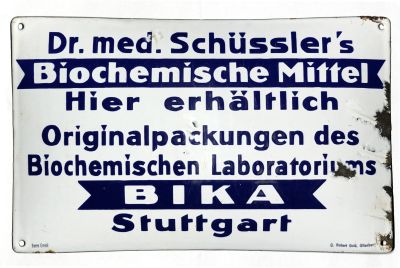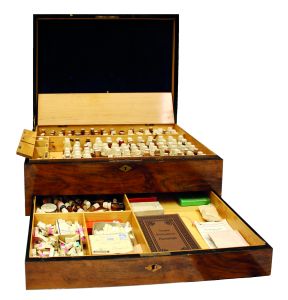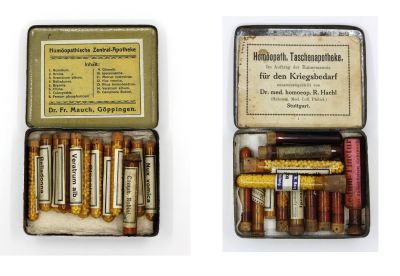New acquisitions for the collections

In spring 2023, the Institute was able to integrate a billboard from the BIKA biochemical laboratory into its collection. In 1920, Valentin Pöhlmann founded the compagny BIKA Chemisch-Pharmazeutische Fabrik in Stuttgart together with the pharmacist Robert Nagel from Schwäbisch Gmünd. The company was initially located in Rotebühlstraße before moving to Talstraße in Stuttgart-Ostheim in 1928. Production began with a stirring machine and an ointment preparation machine. More was actually planned, but even in those years Pöhlmann experienced delivery problems: some of the required machines could only be assembled and put into operation after a delay. It was advertised that production was carried out under the "constant supervision" of the two pharmacists Fuchs and Lacour from the former court pharmacy.
The focus was on the production of biochemical medicines according to Dr Schuessler, and the product range was later expanded to include other "biological specialities". This therapy method, which is also very well-known again today, became very popular in the 1920s. Numerous biochemical lay associations were founded during this time. BIKA was one of the best-known manufacturers of the remedies at this time. Major competitors were the Madaus company in Radebeul and the Schwabe company in Leipzig.
Like the other manufacturers, BIKA also presented its products for example at the Bundestag of the Biochemical Association of Germany (Biochemischer Bund Deutschland), in order to attract new customers. By 1930, the company already had branches in Berlin and Hamburg and advertised its own range as being of high quality as a result of careful production. In addition to biochemical medicines in triturations, tablets and liquid form, biochemical ointments and soaps were also produced. There were also speciality products such as Bikarol and Bioxosan, about which virtually nothing is known today. The company was finally discontinued at the end of the 1950s and was largely forgotten. In addition to the now acquired sign, a series of pictures of BIKA, which are already available at the Institute, provide an insight into production at that time. The collection also contains individual pharmaceutical packaging from the company.

A truly weighty object was delivered in January: a homeopathic "travelling kit " in walnut veneer from Ettlingen in Baden. With its dimensions of 68 centimetres long, 22 cm high and 45 centimetres wide, as well as the fine inlay work, it is visually impressive in itself. The pharmacy is also filled with numerous bottles and labels for labelling.
Our research revealed that the Ettlingen town pharmacy was mentioned as early as 1718 and is the oldest pharmacy in the town. Friedrich Wilhelm Tummer acquired the pharmacy in 1904. His name can also be recognised on the labels, so the "travelling kit" that we were able to acquire at an auction house in Saxony probably dates from this period. How the pharmacy came to Saxony and why there was a "Notopfer Berlin" tax stamp in the drawer, among other things, can still be researched. However, it can be assumed that the heavy box was possibly used as a "homeopathic dispensary".
Special regulations applied to the storage and sale of homeopathic active ingredients and to the operation of pharmacies in general. Although some pharmacists wanted to offer customers the special medicines, they did not have separate premises available or did not want to go to the trouble of doing so. One possibility was a so-called "dispensary", which contained the required ingredients and their potencies in separate cabinets or, as in this case, boxes. In the specimen we have now acquired, for example, we can also see that strong-acting remedies were separated again within the box and stored in extra lockable compartments. This was required by the regulations in Württemberg, for example. Although Baden itself had not issued any special regulations on the establishment and operation of homeopathic pharmacies, the pharmacists presumably took care to maintain the trust of their customers by having a separate facility. The fact that Tummer did not always prepare the remedies himself is also shown by the vials from the Mayer pharmacy in Bad Cannstatt.

After reading the description, it was clear that the two pocket pharmacies offered at an auction in May 2023 were a speciality and that the IGM would therefore place a bid: "Homeopathic pocket pharmacies: compiled in tin cans by Dr med. homoeop. Dr Fr Mauch Göppingen. 1 x Hahnemania Landesverein for war needs. Equipped with glass vials. With instruction booklet. Lid rubbed. Signs of age". Because the "Homeopathic pocket pharmacy for home and travelling use" also contained in the lot was previously only known from corresponding advertisements in lay magazines. In addition, virtually no such items from the Mauch pharmacy in Göppingen had survived or were known to have been preserved in other collections. But the luckily acquired lot held another surprise in store: on closer inspection, the accompanying "Hahnemannia homeopathic wartime pocket pharmacy" turned out to be another previously unpreserved specimen.
Until the acquisition of the new addition, the IGM's collection already included an empty wartime pocket pharmacy, which had been misused as a storage container for screws in the course of its existence and is therefore no longer in such good condition. There is also a Hahnemannia wartime pocket pharmacy that has not been completely preserved. This and a similar item from Willmar Schwabe were presented at a conference on "Objects as sources of medical history" in 2019.
Closer examination of the new additions showed that the contents of the new war chest pharmacy differed from those of the existing one. This one was originally supposed to contain 14 remedies, whereas the instructions for use of the other one listed 15 remedies. The composition of the active ingredients was also different. It is particularly interesting that the bottle for the Ledum remedy, which was intended for external use, has been preserved in the pharmacy acquired. This active ingredient was no longer listed in the existing tin. Instead, it contained Arnica and Ferrum phosphoricum. But how does it all fit together?
The solution can be found by looking at the history of the development of these wartime pocket pharmacies. After the start of the First World War, the homeopathic lay association Hahnemannia in Stuttgart developed small tin cans with homeopathic medicines for the soldiers who had moved out from September 1914 in cooperation with the Mauch pharmacy in Göppingen, so that they could help themselves with minor health problems at the front. This was primarily intended for the members of homeopathic lay associations. The first version of this wartime pocket pharmacy cost 75 pfennigs and contained "14 of the most important remedies for wartime needs". However, a corresponding pocket pharmacy with 15 remedies was advertised as early as December of that year. It is therefore clear that the newly acquired object was one of the first homeopathic pocket pharmacies of the Hahnemannia, whereas the existing pharmacy can probably be dated to 1915. After the end of the First World War, the small, practical tin box continued to be produced. It was now sold for seven marks as a pocket pharmacy for home and travelling use by the Mauch pharmacy in Göppingen. The other newly acquired tin can can therefore be dated to the period after 1919.
The homeopathic physician Richard Haehl (1873-1932) developed the instructions for the use of the remedies and their composition. The origin of the IGM collection goes back to him. In this respect, the two special pocket pharmacies are an excellent addition to our unique collection.


